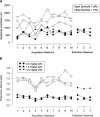Galantamine facilitates acquisition of a trace-conditioned eyeblink response in healthy, young rabbits
- PMID: 14747525
- PMCID: PMC321322
- DOI: 10.1101/lm.66204
Galantamine facilitates acquisition of a trace-conditioned eyeblink response in healthy, young rabbits
Abstract
Previous work has demonstrated that drugs increasing brain concentrations of acetylcholine can enhance cognition in aging and brain-damaged organisms. The present study assessed whether galantamine (GAL), an allosteric modulator of nicotinic cholinergic receptors and weak acetylcholinesterase inhibitor, could improve acquisition and retention of an eyeblink (EB) classical conditioning task in healthy, young animals. We trained 24 rabbits (n = 8/group) in a 1000-msec trace Pavlovian EB conditioning paradigm in which a tone conditioned stimulus (CS) was presented for 500 msec, followed by a 500-msec trace period in which no stimuli were presented. A 100-msec corneal airpuff was the unconditioned stimulus (US). Acquisition sessions, consisting of 100 trials each, occurred daily for 10 consecutive days, followed by 3 d of extinction training. Animals were treated with one of three doses of GAL (0.0-3.0 mg/kg) prior to each session. Animals that received 3.0 mg/kg GAL showed significantly more EB conditioned responses (CRs) in fewer training trials than animals receiving either 1.5 mg/kg GAL or vehicle injections. GAL had no effect on CR performance during extinction. Pseudoconditioning control experiments, consisting of 200 explicitly unpaired tone-puff presentations indicated that GAL did not increase reactivity to the CS or US. These findings indicate that GAL may improve acquisition of moderately difficult associative learning tasks in healthy young organisms.
Figures





References
-
- Arnold, H.M., Burk, J.A., Hodgson, E.M., Sarter, M., and Bruno, J.P. 2002. Differential cortical acetylcholine release in rats performing a sustained attention task versus behavioral control tasks that do not explicitly tax attention. Neuroscience 114: 451–460. - PubMed
-
- Barnes, C.A., Meltzer, J., Houston, F., Orr, G., McGann, K., and Wenk, G.L. 2000. Chronic treatment of old rats with donepezil or galantamine: Effects on memory, hippocampal plasticity and nicotinic receptors. Neuroscience 99: 17–23. - PubMed
-
- Bartus, R.T., Reinald III, L.D., Beer, B., and Lippan, A.S. 1982. The cholinergic hypothesis of geriatric memory dysfunction. Science 217: 408–417. - PubMed
-
- Buchanan, S.L. and Powell, D.A. 1982. Cingulate cortex: Its role in Pavlovian conditioning. J. Compar. Physiol. Psych. 96: 755–774. - PubMed
Publication types
MeSH terms
Substances
LinkOut - more resources
Full Text Sources
